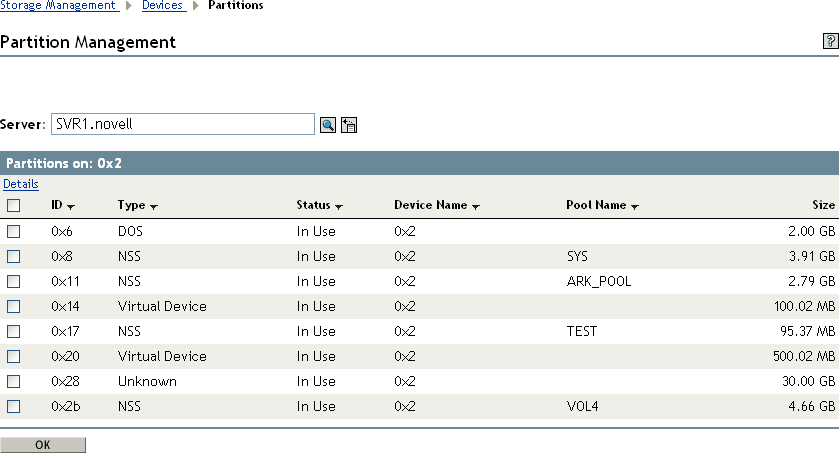12.1 Understanding Partitions
12.1.1 NSS Partitions
A partition is a logical division of a physical hard drive. In NetWare® 6.5 and later, NSS abstracts all partition creation and deletion in iManager and NSSMU through the page and the page. When you create NSS pools or NSS software RAID devices, NSS automatically creates the NSS partitions on the devices you specify. In NetWare 6.5 SP2 and later, you can view and label these NSS partitions from the page.
Partitions are automatically managed by NSS whenever you create pools. You do not manage NSS partitions directly. Table 12-1 identifies the tools used by NSS for managing devices and partitions:
Table 12-1 Device and Partition Managers
12.1.2 Viewing Partitions on a Device
The Partitions page in iManager reports the partitions that it finds on your system and information about them. Select a device to view information about the partition in the area.
Figure 12-1 Example Partitions Page

12.1.3 Understanding Types of Partitions
The following table describes the variety of partition types that iManager reports as being on your system. The Linux partition types are found only on OES Linux servers, not on OES NetWare servers.
The Partitions function in iManager and NSSMU is intended simply as a reporting tool so that you can see the types of partitions that are being virtualized by higher-level storage entities such as pools or software RAID devices. Generally, you cannot create or modify partitions with iManager or NSSMU tools. On NetWare, NSSMU allows you to create an NSS partition, but this capability is seldom used. For NSS on either platform, NSS partitions are created for you automatically when you create a pool. There might be multiple NSS partitions that are aggregated and managed underneath the single pool of space. Similarly, the tools automatically create a Virtual Device when you create a RAID device.
IMPORTANT:You cannot create any of the reported partition types in iManager; you can only view and label NSS partitions from the Partitions page.
Table 12-2 Explanation of Partition Types
12.1.4 Understanding Partition Details
You can view the following information about partitions:
Table 12-3 Explanation of Partition Details